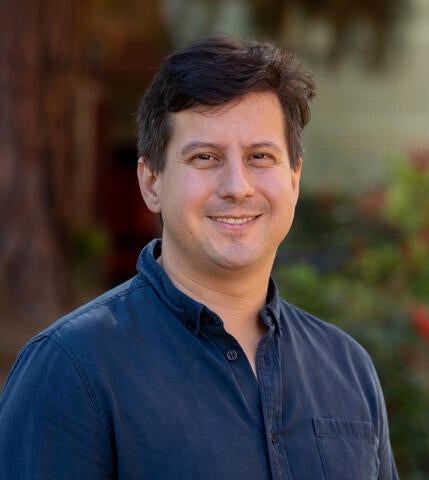
Physicists Miguel Arratia and Shawn Westerdale at UC Riverside have each been awarded a grant from the U.S. Department of Energy, or DOE, to fund their research. Arratia will lead a project titled “Toward quantum imaging of nuclei.” Westerdale will lead a project titled “Developing low-threshold liquid argon time projection chambers with photo-sensitive dopants for dark matter and neutrino experiments.”
The two assistant professors of physics and astronomy join 89 early career scientists from across the country who were selected by the DOE as “the next generation of STEM leaders to solidify America’s role as the driver of science and innovation around the world.” Each award is approximately $875,000 over five years. The awardees were selected based on peer review by outside scientific experts.
Arratia’s project will contribute to our understanding of how quarks and gluons form the atomic nucleus. While this is not yet clear, quantum imaging can help by providing detailed “pictures” of their positions, movements, and interactions. Arratia’s experiments at the Thomas Jefferson National Accelerator Facility will use a powerful electron beam to investigate various nuclear targets, from lithium to lead.
“We want to use electron scattering experiments to map the 3D structure of the atomic nucleus,” he said. “It’s like using an electron microscope, but with enough detail to distinguish features due to the core building blocks.”

Westerdale’s project aims to improve the detection of fundamental particles. Liquid argon can detect fundamental particles because it produces strong signals when particles interact with it. One type of detector, a time projection chamber with photodetectors, can measure faint signals from interactions in liquid argon. Westerdale’s project aims to improve these detectors by adding “photo-sensitive” dopants to the liquid argon.
“Adding photo-sensitive dopants to dark matter and neutrino detectors filled with liquid argon will cause the detectors to make larger signals and allow signals from lower-energy interactions to be efficiently measured above noise,” he said. “These properties will allow faint signals from light dark matter candidates or neutrinos to be measured, and such detectors will be readily scaled to very large sizes so that they can measure rare interactions.”
Shan-Wen Tsai, chair of the Department of Physics and Astronomy, said in exploring profound questions about what makes up our universe Arratia and Westerdale will develop advanced instruments in their labs that push the boundaries of scientific exploration.
“This instrumentation provides training and research opportunities for undergraduate and graduate students and postdocs, as well as outreach opportunities to K-12 students, community college students, and the general public,” she said.